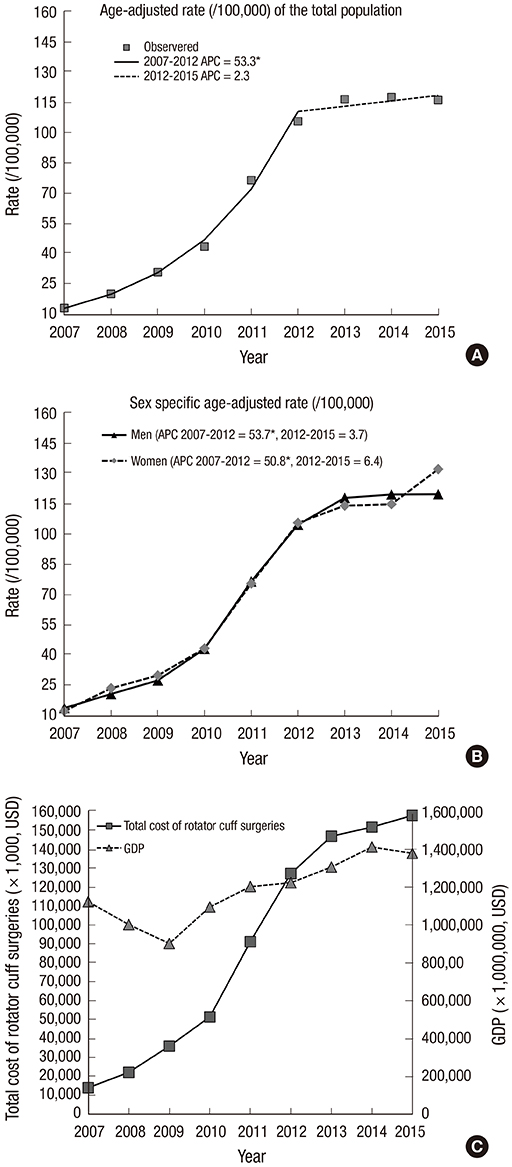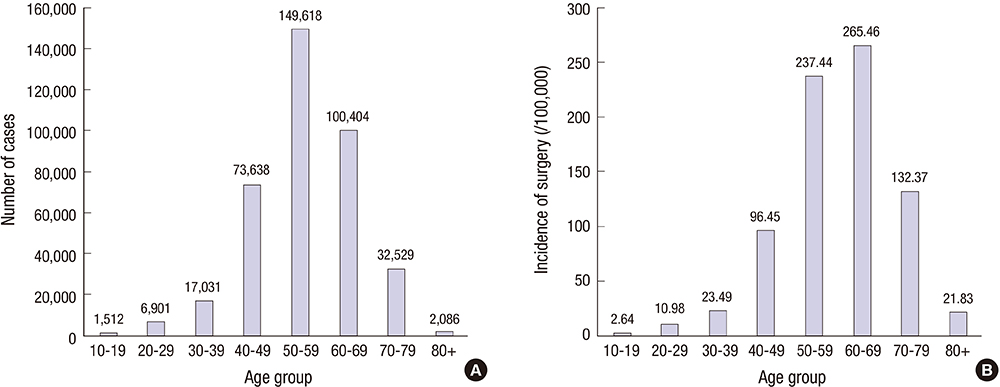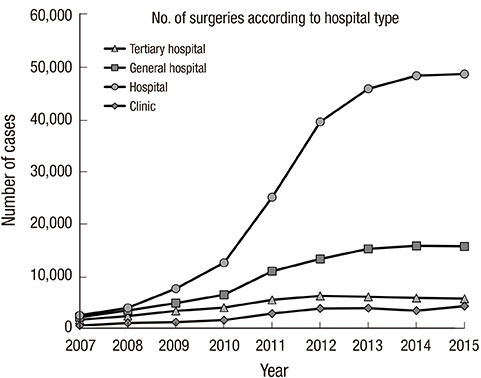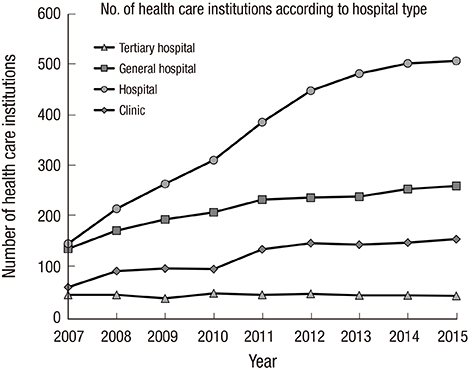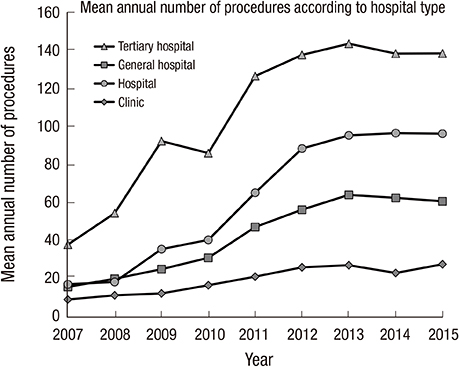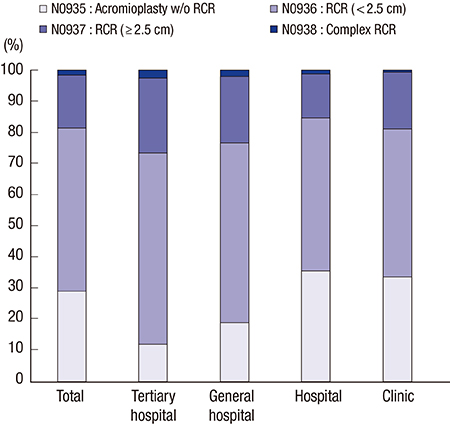J Korean Med Sci.
2017 Feb;32(2):357-364. 10.3346/jkms.2017.32.2.357.
National Trends in Surgery for Rotator Cuff Disease in Korea
- Affiliations
-
- 1Department of Orthopaedic Surgery, Hanyang University College of Medicine, Seoul, Korea. orthdr@naver.com
- 2Department of Orthopaedic Surgery, KEPCO Medical Center, Seoul, Korea.
- KMID: 2364183
- DOI: http://doi.org/10.3346/jkms.2017.32.2.357
Abstract
- The objective of this study was to investigate the national trends in rotator cuff surgery in Korea and analyze hospital type-specific trends. We analyzed a nationwide database acquired from the Korean Health Insurance Review and Assessment Service (HIRA) from 2007 to 2015. International Classification of Diseases, 10th revision (ICD-10) codes, procedure codes, and arthroscopic device code were used to identify patients who underwent surgical treatment for rotator cuff disease. A total of 383,719 cases of rotator cuff surgeries were performed from 2007 to 2015. The mean annual percentage change in the age-adjusted rate of rotator cuff surgery per population of 100,000 persons rapidly increased from 2007 to 2012 (53.3%, P < 0.001), while that between 2012 to 2015 remained steady (2.3%, P = 0.34). The proportion of arthroscopic surgery among all rotator cuff surgeries steadily rose from 89.9% in 2007 to 96.8% in 2015 (P < 0.001). In terms of hospital types, the rate of rotator cuff surgery increased to the greatest degree in hospitals with 30-100 inpatient beds, and isolated acromioplasty procedure accounted for a larger proportion of the rotator cuff surgeries in small hospitals and clinics compared to large hospitals. Overall, our findings indicate that cases of rotator cuff surgery have increased rapidly recently in Korea, of which arthroscopic surgeries account for the greatest proportion. While rotator cuff surgery is a popular procedure that is commonly performed even in small hospitals, there was a difference in the component ratio of the procedure code in accordance with hospital type.
Keyword
MeSH Terms
Figure
Cited by 1 articles
-
National Trends in the Repair of Isolated Superior Labral Tear from Anterior to Posterior in Korea
Young-Hoon Jo, Hyun-Keun Oh, Soo-Young Jeong, Bong-Gun Lee
J Korean Med Sci. 2020;35(34):e285. doi: 10.3346/jkms.2020.35.e285.
Reference
-
1. Neer CS 2nd. Impingement lesions. Clin Orthop Relat Res. 1983; 70–77.2. Coghlan JA, Buchbinder R, Green S, Johnston RV, Bell SN. Surgery for rotator cuff disease. Cochrane Database Syst Rev. 2008; CD005619.3. Chaudhury S, Gwilym SE, Moser J, Carr AJ. Surgical options for patients with shoulder pain. Nat Rev Rheumatol. 2010; 6:217–226.4. Tashjian RZ. Epidemiology, natural history, and indications for treatment of rotator cuff tears. Clin Sports Med. 2012; 31:589–604.5. Vitale MA, Arons RR, Hurwitz S, Ahmad CS, Levine WN. The rising incidence of acromioplasty. J Bone Joint Surg Am. 2010; 92:1842–1850.6. Colvin AC, Egorova N, Harrison AK, Moskowitz A, Flatow EL. National trends in rotator cuff repair. J Bone Joint Surg Am. 2012; 94:227–233.7. Judge A, Murphy RJ, Maxwell R, Arden NK, Carr AJ. Temporal trends and geographical variation in the use of subacromial decompression and rotator cuff repair of the shoulder in England. Bone Joint J. 2014; 96-B:70–74.8. Zhang AL, Montgomery SR, Ngo SS, Hame SL, Wang JC, Gamradt SC. Analysis of rotator cuff repair trends in a large private insurance population. Arthroscopy. 2013; 29:623–629.9. Ensor KL, Kwon YW, Dibeneditto MR, Zuckerman JD, Rokito AS. The rising incidence of rotator cuff repairs. J Shoulder Elbow Surg. 2013; 22:1628–1632.10. Yamamoto A, Takagishi K, Osawa T, Yanagawa T, Nakajima D, Shitara H, Kobayashi T. Prevalence and risk factors of a rotator cuff tear in the general population. J Shoulder Elbow Surg. 2010; 19:116–120.11. Martin CT, Gao Y, Pugely AJ, Wolf BR. 30-day morbidity and mortality after elective shoulder arthroscopy: a review of 9410 cases. J Shoulder Elbow Surg. 2013; 22:1667–1675.e1.12. Iyengar JJ, Samagh SP, Schairer W, Singh G, Valone FH 3rd, Feeley BT. Current trends in rotator cuff repair: surgical technique, setting, and cost. Arthroscopy. 2014; 30:284–288.13. Anderson RN, Rosenberg HM. Age standardization of death rates: implementation of the year 2000 standard. Natl Vital Stat Rep. 1998; 47:1–16.14. Klein RJ, Schoenborn CA. Age adjustment using the 2000 projected U.S. population. Healthy People 2010 Stat Notes. 2001; 1–10.15. Mauro CS, Jordan SS, Irrgang JJ, Harner CD. Practice patterns for subacromial decompression and rotator cuff repair: an analysis of the American Board of Orthopaedic Surgery database. J Bone Joint Surg Am. 2012; 94:1492–1499.16. Dunn WR, Schackman BR, Walsh C, Lyman S, Jones EC, Warren RF, Marx RG. Variation in orthopaedic surgeons' perceptions about the indications for rotator cuff surgery. J Bone Joint Surg Am. 2005; 87:1978–1984.17. Roy JS, Braën C, Leblond J, Desmeules F, Dionne CE, MacDermid JC, Bureau NJ, Frémont P. Diagnostic accuracy of ultrasonography, MRI and MR arthrography in the characterisation of rotator cuff disorders: a systematic review and meta-analysis. Br J Sports Med. 2015; 49:1316–1328.18. Sperling JW, Smith AM, Cofield RH, Barnes S. Patient perceptions of open and arthroscopic shoulder surgery. Arthroscopy. 2007; 23:361–366.19. Yamaguchi K, Ball CM, Galatz LM. Arthroscopic rotator cuff repair: transition from mini-open to all-arthroscopic. Clin Orthop Relat Res. 2001; 83–94.20. Park JS, Park HJ, Kim SH, Oh JH. Prognostic factors affecting rotator cuff healing after arthroscopic repair in small to medium-sized tears. Am J Sports Med. 2015; 43:2386–2392.21. Le BT, Wu XL, Lam PH, Murrell GA. Factors predicting rotator cuff retears: an analysis of 1000 consecutive rotator cuff repairs. Am J Sports Med. 2014; 42:1134–1142.22. McElvany MD, McGoldrick E, Gee AO, Neradilek MB, Matsen FA 3rd. Rotator cuff repair: published evidence on factors associated with repair integrity and clinical outcome. Am J Sports Med. 2015; 43:491–500.23. Yoo JC, Rhee YG, Shin SJ, Park YB, McGarry MH, Jun BJ, Lee TQ. Subscapularis tendon tear classification based on 3-dimensional anatomic footprint: a cadaveric and prospective clinical observational study. Arthroscopy. 2015; 31:19–28.24. Aagaard KE, Abu-Zidan F, Lunsjo K. High incidence of acute full-thickness rotator cuff tears. Acta Orthop. 2015; 86:558–562.25. Park JY, Chung SW, Lee SJ, Cho HW, Lee JH, Lee JH, Oh KS. Combined subscapularis tears in massive posterosuperior rotator cuff tears: do they affect postoperative shoulder function and rotator cuff integrity? Am J Sports Med. 2016; 44:183–190.26. Bartl C, Senftl M, Eichhorn S, Holzapfel K, Imhoff A, Salzmann G. Combined tears of the subscapularis and supraspinatus tendon: clinical outcome, rotator cuff strength and structural integrity following open repair. Arch Orthop Trauma Surg. 2012; 132:41–50.27. Ketola S, Lehtinen J, Arnala I, Nissinen M, Westenius H, Sintonen H, Aronen P, Konttinen YT, Malmivaara A, Rousi T. Does arthroscopic acromioplasty provide any additional value in the treatment of shoulder impingement syndrome?: a two-year randomised controlled trial. J Bone Joint Surg Br. 2009; 91:1326–1334.
- Full Text Links
- Actions
-
Cited
- CITED
-
- Close
- Share
- Similar articles
-
- Biological Characteristics of Rotator Cuff Tendon
- Revisional Rotator Cuff Repair
- Intramuscular Cyst of the Rotator Cuff Associated with Tear of the Rotator Cuff: A Case Report
- Ultrasound Images after Rotator Cuff Surgery: Usefulness of Postoperative Follow-Up
- Delaminated Rotator Cuff Tear: Concurrent Concept and Treatment

